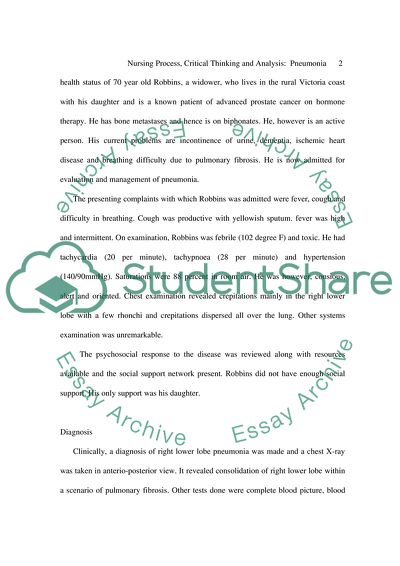Cite this document
(Nursing Process for Pneumonia Case Study Example | Topics and Well Written Essays - 1500 words, n.d.)
Nursing Process for Pneumonia Case Study Example | Topics and Well Written Essays - 1500 words. https://studentshare.org/medical-science/1743499-during-his-young-adulthood-and-middle-years-mr-robbins-had-only-seen-a-gp-infrequently-and-had-been-hospitalised-only-once-as-a-child-however-his-recent-illnesses-have-necessitated-a-range-of-outpatient-treatments-and-now-a-hospital-admission-for
Nursing Process for Pneumonia Case Study Example | Topics and Well Written Essays - 1500 words. https://studentshare.org/medical-science/1743499-during-his-young-adulthood-and-middle-years-mr-robbins-had-only-seen-a-gp-infrequently-and-had-been-hospitalised-only-once-as-a-child-however-his-recent-illnesses-have-necessitated-a-range-of-outpatient-treatments-and-now-a-hospital-admission-for
(Nursing Process for Pneumonia Case Study Example | Topics and Well Written Essays - 1500 Words)
Nursing Process for Pneumonia Case Study Example | Topics and Well Written Essays - 1500 Words. https://studentshare.org/medical-science/1743499-during-his-young-adulthood-and-middle-years-mr-robbins-had-only-seen-a-gp-infrequently-and-had-been-hospitalised-only-once-as-a-child-however-his-recent-illnesses-have-necessitated-a-range-of-outpatient-treatments-and-now-a-hospital-admission-for.
Nursing Process for Pneumonia Case Study Example | Topics and Well Written Essays - 1500 Words. https://studentshare.org/medical-science/1743499-during-his-young-adulthood-and-middle-years-mr-robbins-had-only-seen-a-gp-infrequently-and-had-been-hospitalised-only-once-as-a-child-however-his-recent-illnesses-have-necessitated-a-range-of-outpatient-treatments-and-now-a-hospital-admission-for.
“Nursing Process for Pneumonia Case Study Example | Topics and Well Written Essays - 1500 Words”. https://studentshare.org/medical-science/1743499-during-his-young-adulthood-and-middle-years-mr-robbins-had-only-seen-a-gp-infrequently-and-had-been-hospitalised-only-once-as-a-child-however-his-recent-illnesses-have-necessitated-a-range-of-outpatient-treatments-and-now-a-hospital-admission-for.


